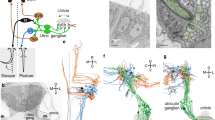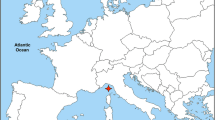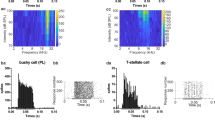Abstract
MICROANATOMICAL1–4 and electrophysiological5–8 investigations support the hypothesis that the sensory elements of the statocysts of Crustacea and of the vertebrate vestibular endorgans are stimulated adequately by lateral displacement (shear) exerted by the statolith or statoconial membrane. Behavioural findings agree with this kind of statocyst stimulation; for example, equilibrium reactions of fish9 and Crustacea10, and counterrolling of eyes and perception of vertical in humans11–15. These reactions are influenced by both parameters which determine shear, that is to say, they depend as much on the direction (which can be changed by tilting the subject) as on the magnitude of the gravito-inertial force.
This is a preview of subscription content, access via your institution
Access options
Subscribe to this journal
Receive 51 print issues and online access
$199.00 per year
only $3.90 per issue
Buy this article
- Purchase on Springer Link
- Instant access to full article PDF
Prices may be subject to local taxes which are calculated during checkout
Similar content being viewed by others
References
Lowenstein, O., and Wersäll, J., Nature, 184, 1807 (1959).
Engström, H., and Wersäll, J., Exp. Cell Res., suppl. 5, 460 (1958).
Spoendlin, H., Schweiz. Archiv. Neurol. Neurochirurg. Psych., 96 (2) (1965).
Schöne, H., and Steinbrecht, R. A., Nature, 220, 184 (1968).
van Békésy, G., J. Acoust. Soc. Amer., 25, 786 (1953).
Trincker, D., Symp. Soc. Exp. Biol., 16, 289 (1962).
Flock, A., Cold Spring Harb. Symp. Quant. Biol., 30, 133 (1965).
Giesen, M., and Klinke, R., Acta Oto-laryng., 67, 49 (1969).
von Holst, E., Z. Vergl. Physiol., 32, 60 (1950).
Schöne, H., Z. Vergl. Physiol., 36, 241 (1954); ibid., 39, 235 (1957).
Miller, E. F., and Graybiel, A., Aerospace Med., 34, 915 (1963).
Colenbrander, A., Aeromed. Acta, 9, 45 (1963/1964).
Schöne, H., Z. Vergl. Physiol., 46, 57 (1962).
Schöne, H., Aerospace Med., 35, 764 (1964).
Schöne, H., and Parker, D. E., Naturwissenschaften, 54, 288 (1967).
Young, J. Z., Proc. Roy. Soc. B, 152, 3 (1960).
Barber, V. C., Z. Zellforschung, 70, 91 (1966).
Barber, V. C., Symp. Zool. Soc. Lond., 23, 37 (1968).
Barber, V. C., J. Anat. Lond., 100, 685 (1966).
Wells, M. J., J. Exp. Biol., 37, 489 (1960).
Dijkgraaf, S., Pubbl. Staz. Zool. Napoli, 32, 64 (1961).
Author information
Authors and Affiliations
Rights and permissions
About this article
Cite this article
SCHÖNE, H., BUDELMANN, BU. Function of the Gravity Receptor of Octopus vulgaris. Nature 226, 864–865 (1970). https://doi.org/10.1038/226864a0
Received:
Revised:
Issue Date:
DOI: https://doi.org/10.1038/226864a0
This article is cited by
-
Eye stabilization by statocyst mediated oculomotor reflex inNautilus
Journal of Comparative Physiology ? A (1979)
-
Die Arbeitsweise der Statolithenorgane von Octopus vulgaris
Zeitschrift f�r Vergleichende Physiologie (1970)
Comments
By submitting a comment you agree to abide by our Terms and Community Guidelines. If you find something abusive or that does not comply with our terms or guidelines please flag it as inappropriate.



